作者简介:Patrick Triest是一位全栈工程师,数据爱好者,持续学习者,洁癖编程者。作者github地址为github.com/triestpa,本文地址参见blog.patricktriest.com ... arch/】
本文源码可以在GitHub repository 中找到 - github.com/triestpa/gu…。
给应用添加快速、灵活的全文本搜索对谁都不是一件容易的事情。许多主流数据库,如PostgreSQL和MongoDB,受限于查询和索引结构,只提供基础文本搜索能力。为了提供高效全文本搜索一般都需要一个独立的数据库。Elasticsearch正是这样一个能够提供灵活性和快速全文本搜索能力的开源数据库。
本文采用Docker来设置依赖环境。Docker是目前最常见的容器化引擎,Uber、Spotify、ADP和Paypal都是用这个技术,它的优势在于操作系统无关,可以运行在Windows、macOS和Linux之上------写操作指南很容易。如果从来没有用过Docker也没问题,本文会详细提供配置文件。
本文也分别采用Node.js(采用Koa框架),和Vue.js创建搜索API和前端web应用。
而本文提供的搜索应用能够提供:
1. 快速:查询结果应该实时返回,提高用户体验。
2. 灵活:根据不同数据和使用场景,可以调整搜索过程
3. 最佳建议:对于输入错误,返回最可能的结果。
4. 全文本:除了搜索关键词和标签之外,希望能够搜索到所有匹配文本
实现以上要求的搜索应用,最好采用一个为全文本检索优化的数据库,这也是本文采用Elasticsearch的原因。Elasticsearch是一个用Java开发的,开源的内存数据库,最开始是包含在Apache Lucene库中。以下是一些官方给出的Elasticsearch使用场景:
1. Wikipedia使用Elasticsearch提供全文检索,提供高亮显示、search-as-you-type和did-you-mean建议等功能。
2. Guardian使用Elasticsearch将访问者社交数据整合反馈给作者。
3.Stack Overflow将位置信息和more-like-this功能与全文本检索整合提供相关问题和答案。
4.Github使用Elasticsearch在一千三百亿行代码中进行搜索。
“索引”是一种在数据库中提供快速查询和返回的数据结构。数据库一般将数据域和相应表位置生成索引信息。将索引信息存放在一个可搜索的数据结构中(一般是B-Tree),数据库可以为优化数据请求获得线性搜索响应(例如“Find the row with ID=5”)。

可以把数据库索引看做学校图书馆卡片分类系统,只要知道书名和作者,就可以准确告诉查找内容的入口。数据库表一般都有多个索引表,可以加速查询(例如,对name列的索引可以极大加速对特定name的查询)。
而反向索引工作原理与此完全不同。每行(或者每个文档)的内容被分拆,每个入口(本案例中是每个单词)反向指向包含它的文档。
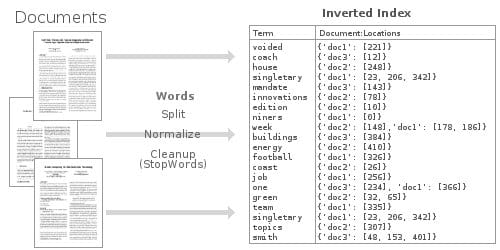
反向索引数据结构对查询“football”位于哪个文档这种查询非常迅速。Elasticsearch使用内存优化反向索引,可以实现强大和客制化全文本检索任务。
对于作者来说,Docker可以提供平台一致性安装环境(可以运行在Windows,macOS和linux系统)。一般Node.js,Elasticsearch和Nginx都需要不同安装步骤,如果运行在Docker环境中只需要定义好不同配置文件,就可以运行在任何Docker环境。另外,由于应用各自运行在隔离容器中,与本地宿主机关系很小,因此类似于“但是我这可以运行啊”这种排错问题就很少会出现。
安装Docker - docs.docker.com/engine/inst…
安装Docker Compose - docs.docker.com/compose/ins…
/public - 为前端 Vue.js webapp存放数据.
/server - 服务器端Node.js 源文件
gs-api - Node.js 容器后端应用逻辑.
gs-frontend - 为前端webapp提供服务的Nginx容器
gs-search- 存储搜索数据的Elasticsearch容器
此文件定义应用栈,而不需要在本地宿主机安装Elasticsearch、Node.js、或者Nginx。每个容器都对宿主机开放相应端口,以便从宿主机访问和排错Node API,Elasticsearch实例和前端应用。
#2.4 添加Dockerfile
本文使用官方的Nginx和Elasticsearch映像,但是需要重新为Node.js创建自己的映像。在
应用根目录定义一个简单的Dockerfile配置文件
此Docker配置文件中将应用源码拷贝进来,安装了NPM依赖包,形成了自己的映像。同样需要添加一个.dockerignore文件,避免不需要的文件被拷入。
下一步,在server/app.js中加入Node.js的应用文件。
最后,加入package.json节点配置文件:
此文件定义应用开始命令和Node.js依赖包。
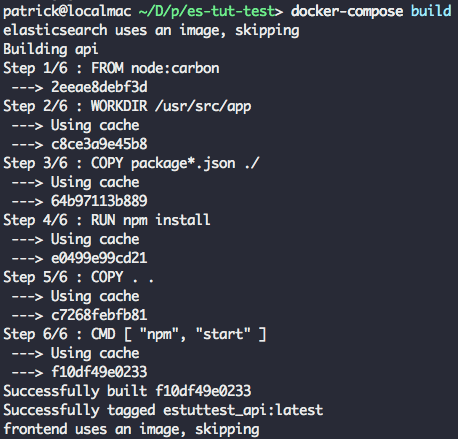
运行docker-compose up启动应用:
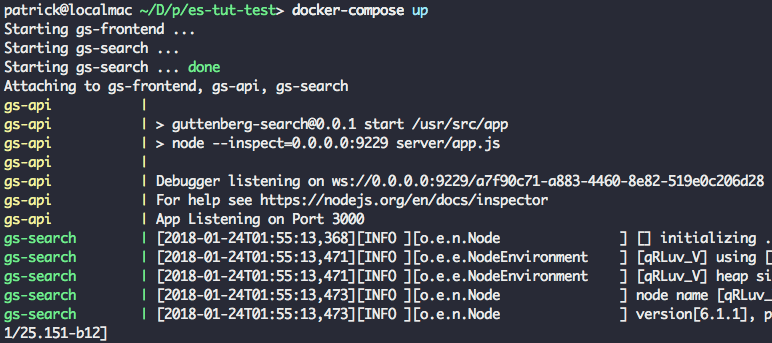

访问localhost:3000 验证服务器端返回“hello world”信息
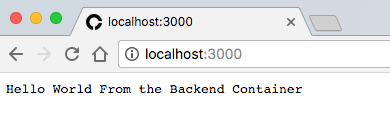
最后,访问localhost:9200确认Elasticsearch是否运行,如果正常,应该返回如下输出:
如果所有URL输出都正常,恭喜,整个应用框架可以正常工作,下面开始进入真正有趣的部分了。
下面用docker-compose来重建更改过的应用。之后运行docker-compose up -d重新启动后台进程。
应用启动后,命令行运行docker exec gs-api "node" "server/connection.js",在容器中运行脚本,应该可以看到如下输出:
如果一切顺利,就可以把最后一行的checkConnection()调用删掉,因为最终应用会从connection模块之外调用它。
#3.1 给Reset Index添加Helper功能
在server/connection.js 文件checkConnection之下添加如下内容, 以便更加方便重置索引。
此处为书目索引定义了mapping(映射)。Elasticsearch索引类似于SQL的表或者MongoDB的connection。通过mapping我们可以定义文档每个域和数据类型。Elasticsearch是schema-less,因此技术上说不需要添加mapping,但是通过mapping可以更好控制数据处理方式。
例如,有两个关键词域,分别是“titile”和“author”,文本定为“text”域。这样定义搜索引擎会有完全不同的动作:搜索中,引擎会在text域中查找可能匹配项,而在关键词域则是精确匹配。看起来差别不大,但却对搜索行为和搜索速度有很大影响。
在文件最后输出功能和属性,可以被其它模块访问。
cdn.patricktriest.com/data/books.… ,之后解压到项目根目录下的books/ 子目录下。
也可以用命令行实现以上操作:
随后是声明信息:*** START OF THIS PROJECT GUTENBERG EBOOK HEART OF DARKNESS ***, 紧接着就是书的实际内容。
书的最后会发现书籍结束声明: *** END OF THIS PROJECT GUTENBERG EBOOK HEART OF DARKNESS ***, 紧跟着是更加详细的书籍license.
下一步将用编程方法从书中提取元数据,并且从***之间将书籍内容抽取出来。
首先,获得books目录下所有文件列表
运行docker-compose -d --build重建映像更新应用。

运行docker exec gs-api "node" "server/load_data.js"调用包含load_data脚本应用,应该看到Elasticsearch输出如下。随后,脚本会因为错误退出,原因是调用了一本目前还不存在的helper函数(parseBookFile).

此函数执行以下功能:
1.从文件系统中读入文件
2.使用正则表达式抽取书名和作者
3.通过定位***,来抽取书中内容
4.解析出段落
5.清洗数据,移除空行
最后返回一个包含书名、作者和段落列表的对象。
运行docker-compose up -d --build和docker exec gs-api "node" "server/load_data.js" ,输出如下:

到这步,脚本顺利分理出书名和作者,脚本还会因为同样问题出错(调用还未定义的函数)
此函数索引书籍段落,包括作者、书名和段落元数据信息。使用bulk操作插入段落,比分别索引段落效率高很多。
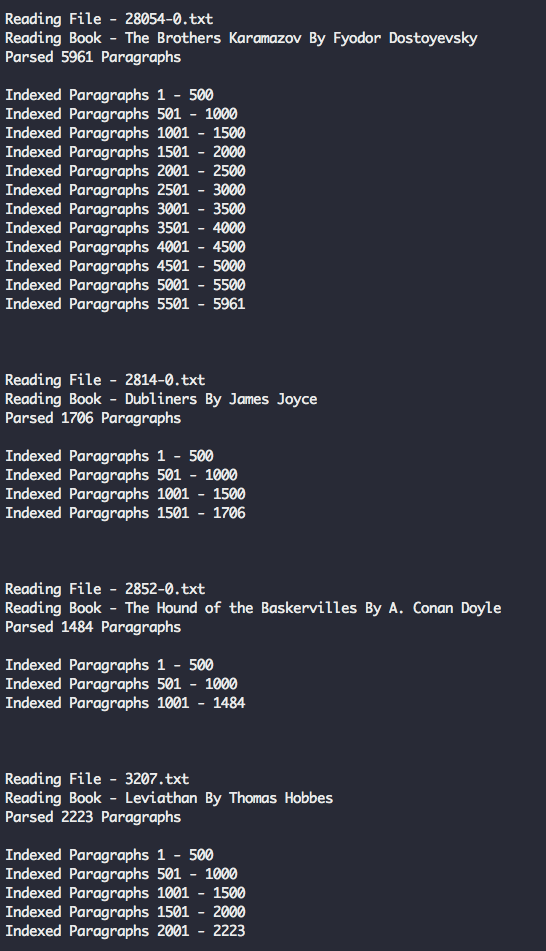
Elasticsearch HTTP接口对于测试数据是否正常插入很有用,但是如果直接暴露给web应用就很危险。不应该将操作性API功能(例如直接添加和删除文档)直接暴露给应用,而应该写一段简单Node.js API接收客户端请求,(通过私网)转发给Elasticsearch进行查询。
本模块定义了一个简单的search功能,使用输入信息进行匹配查询。详细字段解释如下:
1. from:为结果标出页码。每次查询默认返回10个结果;因此指定from为10,可以直接显示10-20的查询结果。
2. query:具体查询关键词
3. operator: 具体查询操作;本例中采用“and”操作符,优先显示包含所有查询关键词的结果。
4. fuzziness: 错误拼写修正级别(或者是模糊查询级别),默认是2。数值越高,允许模糊度越高;例如数值1,会对Patricc的查询返回Patrick结果。
5. highlights:返回额外信息,其中包含HTML格式显示匹配文本信息。
可以调整这些参数看看具体的显示信息,可以查看Elastic Full-Text Query DSL获得更多信息:
这段代码导入服务依赖环境,为Koa.js Node API Server设置简单日志和错误处理机制。
在server/app.js中//ADD ENDPOINTS HERE 之后插入如下代码:
用docker-compose up -d --build 重启服务端。在浏览器中,调用此服务。例如:http://localhost:3000/search?term=java
返回结果看起来应该如下:
我们使用Joi和Koa-Joi-Validate库进行这种类型的验证:
现在如果重启服务端,并做一个缺失参数查询(http://localhost:3000/search),将会返回HTTP 400错误,例如:Invalid URL Query - child "term" fails because ["term" is required]。
可以用docker-compose logs -f api 查看日志。
应用特别简单,只是定义一些共享数据属性,添加一个接收方法以及为结果分页的功能;搜索间隔设置为100ms,以防API被频繁调用。
解释Vue.js如何工作超出本文的范围,如果想了解相关内容,可以查看Vue.js官方文档.
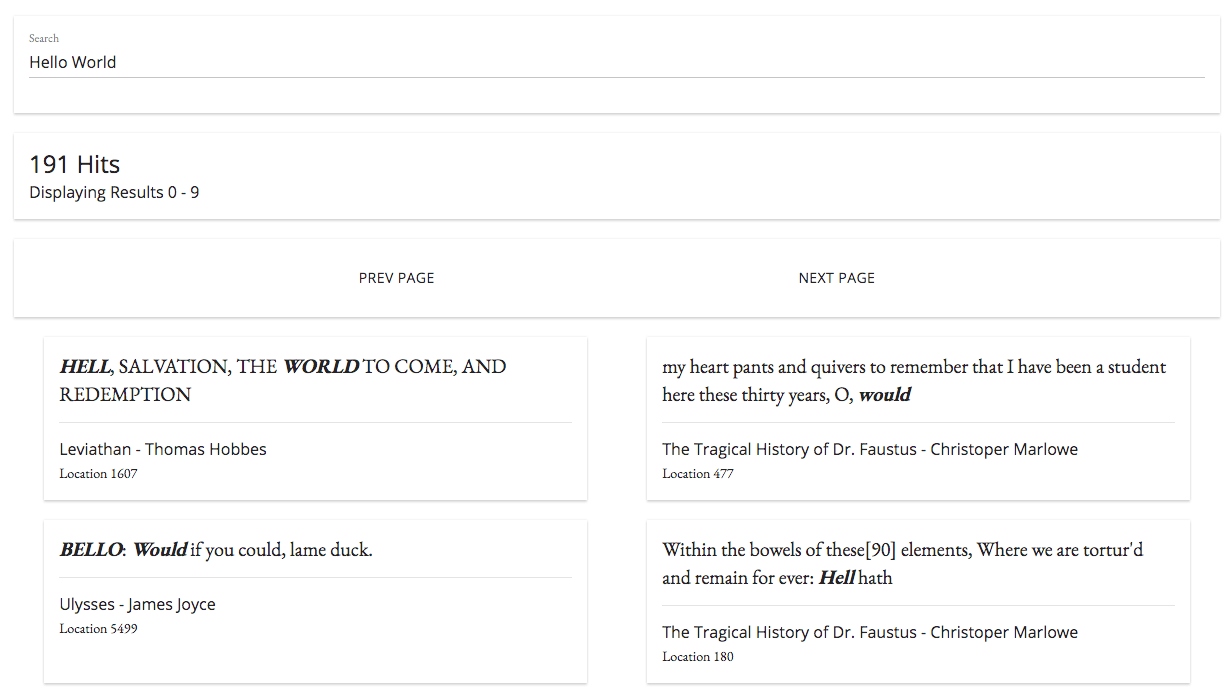
此功能将返回给定书排序后的段落。
以上五个功能块提供在书中下载和分页(每页显示10段)逻辑操作。
在/public/index.html 中的<!-- INSERT BOOK MODAL HERE --> 分界符下加入显示书页的UI代码如下:
重启应用服务器(docker-compose up -d --build),打开localhost:8080。此时如果点击搜索结果,就可以查询段落上下文。如果对查到结果感兴趣,甚至可以从查询处一直读下去。

恭喜!!到这一步主体框架已经搭建完毕。以上所有代码都可以从这里获得。
我在一个1.7GB的云设备上(每月15美金)运行以上示例(search.patriktriest.com),这些资源仅是能够运行Elasticsearch节点。有时整个节点会在初始装载数据时候hang住。从我的经验看,Elasticsearch比传统的PostgreSQL和MongoDB跟消耗资源,如果需要提供理想服务效果,成本可能会很贵。
例如,假设我们需要将用户存放到PostgreSQL表中,但是使用ES承担用户查询功能。如果一个用户,“Albert”,决定修改名字为“Al”,就需要在主PostgreSQL库和ES集群中同时进行修改。
这个操作有些复杂,依赖现有的软件栈。有许多开源资源可选,既有监控MongoDB操作日志并自动同步删除数据到ES的进程,到创建客制化基于PSQL索引自动与ES通讯的PostgreSQL插件。
如果之前提到的选项都无效,可以在服务端代码中根据数据库变化手动更新Elasticsearch索引。但是我认为这种选择并不是最佳的,因为使用客制化商业逻辑保持ES同步很复杂,而且有可能会引入很多bugs。
Elasticsearch与主数据库同步需求,与其说是ES的弱点,不如说是架构复杂造成的;给应用添加一个专用搜索引擎是一件值得考虑的事情,但是要折衷考虑带来的问题。
“search-bar”模式功能远不仅是Elasticsearch的唯一使用场景。ES也是一个日志存储和分析常用工具,一般用于ELK架构(Elasticsearch,Logstash,Kibana)。ES实现的灵活全文本搜索对数据科学家任务也很有用,例如修改、规范化数据集拼写或者搜索数据集。
如下是有关本项目的考虑:
1.在应用中添加更多喜爱的书,创建自己私有库搜索殷勤
2.通过索引google scholar论文,创建一个防抄袭引擎
3.通过索引字典中单词到ES中,建立拼写检查应用
4.通过加载Common Crawl Corpus到ES(注意,有50亿页内容,是一个非常巨大数据集),建立自己的与谷歌竞争的互联网搜索引擎
5.在新闻业中使用Elasticsearch:在例如Panama论文和Paradise论文集中搜索特点名称和词条
本文所有代码都是开源的,可以在Github库中找到,具体下载地址。希望本文对大家有所帮助。
本文源码可以在GitHub repository 中找到 - github.com/triestpa/gu…。
给应用添加快速、灵活的全文本搜索对谁都不是一件容易的事情。许多主流数据库,如PostgreSQL和MongoDB,受限于查询和索引结构,只提供基础文本搜索能力。为了提供高效全文本搜索一般都需要一个独立的数据库。Elasticsearch正是这样一个能够提供灵活性和快速全文本搜索能力的开源数据库。
本文采用Docker来设置依赖环境。Docker是目前最常见的容器化引擎,Uber、Spotify、ADP和Paypal都是用这个技术,它的优势在于操作系统无关,可以运行在Windows、macOS和Linux之上------写操作指南很容易。如果从来没有用过Docker也没问题,本文会详细提供配置文件。
本文也分别采用Node.js(采用Koa框架),和Vue.js创建搜索API和前端web应用。
1 什么是Elasticsearch
现代应用中全文本检索是高请求负载的应用。搜索功能也是比较困难完成的功能(许多大众网站都有subpar功能,但不是返回很慢就是返回结果不准确),大部分原因是因为底层数据库:许多标准关系型数据库只能提供基本字符串匹配功能,而对CONTAINS或者LIKE SQL查询只能提供有限支持。而本文提供的搜索应用能够提供:
1. 快速:查询结果应该实时返回,提高用户体验。
2. 灵活:根据不同数据和使用场景,可以调整搜索过程
3. 最佳建议:对于输入错误,返回最可能的结果。
4. 全文本:除了搜索关键词和标签之外,希望能够搜索到所有匹配文本
实现以上要求的搜索应用,最好采用一个为全文本检索优化的数据库,这也是本文采用Elasticsearch的原因。Elasticsearch是一个用Java开发的,开源的内存数据库,最开始是包含在Apache Lucene库中。以下是一些官方给出的Elasticsearch使用场景:
1. Wikipedia使用Elasticsearch提供全文检索,提供高亮显示、search-as-you-type和did-you-mean建议等功能。
2. Guardian使用Elasticsearch将访问者社交数据整合反馈给作者。
3.Stack Overflow将位置信息和more-like-this功能与全文本检索整合提供相关问题和答案。
4.Github使用Elasticsearch在一千三百亿行代码中进行搜索。
1.1 Elasticsearch有什么独特之处
本质上,Elasticsearch通过使用反向索引提供快速和灵活的全文本搜索。“索引”是一种在数据库中提供快速查询和返回的数据结构。数据库一般将数据域和相应表位置生成索引信息。将索引信息存放在一个可搜索的数据结构中(一般是B-Tree),数据库可以为优化数据请求获得线性搜索响应(例如“Find the row with ID=5”)。

可以把数据库索引看做学校图书馆卡片分类系统,只要知道书名和作者,就可以准确告诉查找内容的入口。数据库表一般都有多个索引表,可以加速查询(例如,对name列的索引可以极大加速对特定name的查询)。
而反向索引工作原理与此完全不同。每行(或者每个文档)的内容被分拆,每个入口(本案例中是每个单词)反向指向包含它的文档。

反向索引数据结构对查询“football”位于哪个文档这种查询非常迅速。Elasticsearch使用内存优化反向索引,可以实现强大和客制化全文本检索任务。
2 项目安装
2.0 Docker
本文使用Docker作为项目开发环境。Docker是一个容器化引擎,应用可以运行在隔离环境中,不依赖于本地草走系统和开发环境。因为可以带来巨大灵活性和客制化,许多互联网公司应用都已经运行在容器中。对于作者来说,Docker可以提供平台一致性安装环境(可以运行在Windows,macOS和linux系统)。一般Node.js,Elasticsearch和Nginx都需要不同安装步骤,如果运行在Docker环境中只需要定义好不同配置文件,就可以运行在任何Docker环境。另外,由于应用各自运行在隔离容器中,与本地宿主机关系很小,因此类似于“但是我这可以运行啊”这种排错问题就很少会出现。
2.1 安装Docker和Docker-compose
本项目只需要Docker和Docker-compose环境。后者是Docker官方工具,在单一应用栈中编排定义多个容器配置。安装Docker - docs.docker.com/engine/inst…
安装Docker Compose - docs.docker.com/compose/ins…
2.2 设置项目安装目录
创建一个项目根目录(例如guttenberg_search),在其下定义两个子目录:/public - 为前端 Vue.js webapp存放数据.
/server - 服务器端Node.js 源文件
2.3 添加docker-compose配置文件
下一步,创建docker-compose.yml文件,定义应用栈中每个容器的配置:gs-api - Node.js 容器后端应用逻辑.
gs-frontend - 为前端webapp提供服务的Nginx容器
gs-search- 存储搜索数据的Elasticsearch容器
version: '3'
services:
api: # Node.js App
container_name: gs-api
build: .
ports:
- "3000:3000" # Expose API port
- "9229:9229" # Expose Node process debug port (disable in production)
environment: # Set ENV vars
- NODE_ENV=local
- ES_HOST=elasticsearch
- PORT=3000
volumes: # Attach local book data directory
- ./books:/usr/src/app/books
frontend: # Nginx Server For Frontend App
container_name: gs-frontend
image: nginx
volumes: # Serve local "public" dir
- ./public:/usr/share/nginx/html
ports:
- "8080:80" # Forward site to localhost:8080
elasticsearch: # Elasticsearch Instance
container_name: gs-search
image: docker.elastic.co/elasticsearch/elasticsearch:6.1.1
volumes: # Persist ES data in seperate "esdata" volume
- esdata:/usr/share/elasticsearch/data
environment:
- bootstrap.memory_lock=true
- "ES_JAVA_OPTS=-Xms512m -Xmx512m"
- discovery.type=single-node
ports: # Expose Elasticsearch ports
- "9300:9300"
- "9200:9200"
volumes: # Define seperate volume for Elasticsearch data
esdata:
此文件定义应用栈,而不需要在本地宿主机安装Elasticsearch、Node.js、或者Nginx。每个容器都对宿主机开放相应端口,以便从宿主机访问和排错Node API,Elasticsearch实例和前端应用。
#2.4 添加Dockerfile
本文使用官方的Nginx和Elasticsearch映像,但是需要重新为Node.js创建自己的映像。在
应用根目录定义一个简单的Dockerfile配置文件
# Use Node v8.9.0 LTS
FROM node:carbon
Setup app working directory
WORKDIR /usr/src/app
Copy package.json and package-lock.json
COPY package*.json ./
Install app dependencies
RUN npm install
Copy sourcecode
COPY . .
Start app
CMD [ "npm", "start" ]
此Docker配置文件中将应用源码拷贝进来,安装了NPM依赖包,形成了自己的映像。同样需要添加一个.dockerignore文件,避免不需要的文件被拷入。
node_modules/
npm-debug.log
books/
public/
注意:不需要将node_modules拷入,因为我们后续要用npm install来安装这些进程。如果拷入node_modules到容器中容易引起兼容性问题。例如在macOS上安装bcrypt包,如果将此module拷入Ubuntu容器就会引起操作系统不匹配问题。
2.5 添加基础文件
测试配置文件前,还需要往应用目录拷入一下占位文件。在public/index.html中加入如下基础配置信息:<html><body>Hello World From The Frontend Container</body></html>
下一步,在server/app.js中加入Node.js的应用文件。
const Koa = require('koa')
const app = new Koa()
app.use(async (ctx, next) => {
ctx.body = 'Hello World From the Backend Container'
})
const port = process.env.PORT || 3000
app.listen(port, err => {
if (err) console.error(err)
console.log(`App Listening on Port ${port}`
})
最后,加入package.json节点配置文件:
{
"name": "guttenberg-search",
"version": "0.0.1",
"description": "Source code for Elasticsearch tutorial using 100 classic open source books.",
"scripts": {
"start": "node --inspect=0.0.0.0:9229 server/app.js"
},
"repository": {
"type": "git",
"url": "git+https://github.com/triestpa/guttenberg-search.git"
},
"author": "patrick.triest@gmail.com",
"license": "MIT",
"bugs": {
"url": "https://github.com/triestpa/guttenberg-search/issues"
},
"homepage": "https://github.com/triestpa/guttenberg-search#readme",
"dependencies": {
"elasticsearch": "13.3.1",
"joi": "13.0.1",
"koa": "2.4.1",
"koa-joi-validate": "0.5.1",
"koa-router": "7.2.1"
}
}
此文件定义应用开始命令和Node.js依赖包。
注意:不需要特意运行npm install,容器创建时候会自动安装依赖包
2.6 开始测试
开起来都准备好了,接下来可以测试了。从项目根目录开始,运行docker-compose,会自动创建Node.js容器应用。
运行docker-compose up启动应用:

注意:这一步可能会运行时间比较长,因为Docker可能需要下载基础映像。以后执行速度会很快,因为本地已经有了基础映像。访问localhost:8080,应该看到如下图输出“hello world”

访问localhost:3000 验证服务器端返回“hello world”信息

最后,访问localhost:9200确认Elasticsearch是否运行,如果正常,应该返回如下输出:
{
"name" : "SLTcfpI",
"cluster_name" : "docker-cluster",
"cluster_uuid" : "iId8e0ZeS_mgh9ALlWQ7-w",
"version" : {
"number" : "6.1.1",
"build_hash" : "bd92e7f",
"build_date" : "2017-12-17T20:23:25.338Z",
"build_snapshot" : false,
"lucene_version" : "7.1.0",
"minimum_wire_compatibility_version" : "5.6.0",
"minimum_index_compatibility_version" : "5.0.0"
},
"tagline" : "You Know, for Search"
}
如果所有URL输出都正常,恭喜,整个应用框架可以正常工作,下面开始进入真正有趣的部分了。
3 接入Elasticsearch
第一步是要接入本地Elasticsearch实例3.0 加入ES链接模块
在server/connection.js中加入如下初始化代码:const elasticsearch = require('elasticsearch')
// Core ES variables for this project
const index = 'library'
const type = 'novel'
const port = 9200
const host = process.env.ES_HOST || 'localhost'
const client = new elasticsearch.Client({ host: { host, port } })
/** Check the ES connection status */
async function checkConnection () {
let isConnected = false
while (!isConnected) {
console.log('Connecting to ES')
try {
const health = await client.cluster.health({})
console.log(health)
isConnected = true
} catch (err) {
console.log('Connection Failed, Retrying...', err)
}
}
}
checkConnection()
下面用docker-compose来重建更改过的应用。之后运行docker-compose up -d重新启动后台进程。
应用启动后,命令行运行docker exec gs-api "node" "server/connection.js",在容器中运行脚本,应该可以看到如下输出:
{ cluster_name: 'docker-cluster',
status: 'yellow',
timed_out: false,
number_of_nodes: 1,
number_of_data_nodes: 1,
active_primary_shards: 1,
active_shards: 1,
relocating_shards: 0,
initializing_shards: 0,
unassigned_shards: 1,
delayed_unassigned_shards: 0,
number_of_pending_tasks: 0,
number_of_in_flight_fetch: 0,
task_max_waiting_in_queue_millis: 0,
active_shards_percent_as_number: 50 }
如果一切顺利,就可以把最后一行的checkConnection()调用删掉,因为最终应用会从connection模块之外调用它。
#3.1 给Reset Index添加Helper功能
在server/connection.js 文件checkConnection之下添加如下内容, 以便更加方便重置索引。
/** Clear the index, recreate it, and add mappings */
async function resetIndex () {
if (await client.indices.exists({ index })) {
await client.indices.delete({ index })
}
await client.indices.create({ index })
await putBookMapping()
}
3.2 添加Book Schema
紧接resetIndex之后,添加如下功能:/** Add book section schema mapping to ES */
async function putBookMapping () {
const schema = {
title: { type: 'keyword' },
author: { type: 'keyword' },
location: { type: 'integer' },
text: { type: 'text' }
}
return client.indices.putMapping({ index, type, body: { properties: schema } })
}
此处为书目索引定义了mapping(映射)。Elasticsearch索引类似于SQL的表或者MongoDB的connection。通过mapping我们可以定义文档每个域和数据类型。Elasticsearch是schema-less,因此技术上说不需要添加mapping,但是通过mapping可以更好控制数据处理方式。
例如,有两个关键词域,分别是“titile”和“author”,文本定为“text”域。这样定义搜索引擎会有完全不同的动作:搜索中,引擎会在text域中查找可能匹配项,而在关键词域则是精确匹配。看起来差别不大,但却对搜索行为和搜索速度有很大影响。
在文件最后输出功能和属性,可以被其它模块访问。
module.exports = {
client, index, type, checkConnection, resetIndex
}
4 加载源数据
本文使用从Gutenberg项目(一个在线提供免费电子书的应用)提供的数据。包括100本经典书目,例如80天环绕地球,罗密欧与朱丽叶以及奥德赛等。4.1 下载书籍数据
本文的数据可以从以下网站下载:cdn.patricktriest.com/data/books.… ,之后解压到项目根目录下的books/ 子目录下。
也可以用命令行实现以上操作:
wget https://cdn.patricktriest.com/data/books.zip
unar books.zip
4.2 预览书籍
打开一本书,例如219-0.txt。书籍以公开访问license开始,跟着是书名、作者,发行日期,语言以及字符编码。Title: Heart of Darkness
Author: Joseph Conrad
Release Date: February 1995 [EBook #219]
Last Updated: September 7, 2016
Language: English
Character set encoding: UTF-8
随后是声明信息:*** START OF THIS PROJECT GUTENBERG EBOOK HEART OF DARKNESS ***, 紧接着就是书的实际内容。
书的最后会发现书籍结束声明: *** END OF THIS PROJECT GUTENBERG EBOOK HEART OF DARKNESS ***, 紧跟着是更加详细的书籍license.
下一步将用编程方法从书中提取元数据,并且从***之间将书籍内容抽取出来。
4.3 读取数据目录
本节写一段脚本读取书籍内容添加到Elasticsearch中,脚本存放在server/load_data.js 中。首先,获得books目录下所有文件列表
const fs = require('fs')
const path = require('path')
const esConnection = require('./connection')
/** Clear ES index, parse and index all files from the books directory */
async function readAndInsertBooks () {
try {
// Clear previous ES index
await esConnection.resetIndex()
// Read books directory
let files = fs.readdirSync('./books').filter(file => file.slice(-4) === '.txt')
console.log(`Found ${files.length} Files`)
// Read each book file, and index each paragraph in elasticsearch
for (let file of files) {
console.log(`Reading File - ${file}`)
const filePath = path.join('./books', file)
const { title, author, paragraphs } = parseBookFile(filePath)
await insertBookData(title, author, paragraphs)
}
} catch (err) {
console.error(err)
}
}
readAndInsertBooks()
运行docker-compose -d --build重建映像更新应用。

运行docker exec gs-api "node" "server/load_data.js"调用包含load_data脚本应用,应该看到Elasticsearch输出如下。随后,脚本会因为错误退出,原因是调用了一本目前还不存在的helper函数(parseBookFile).

4.4 读取数据文件
创建server/load_data.js文件,读取每本书元数据和内容:/** Read an individual book text file, and extract the title, author, and paragraphs */
function parseBookFile (filePath) {
// Read text file
const book = fs.readFileSync(filePath, 'utf8')
// Find book title and author
const title = book.match(/^Title:\s(.+)$/m)[1]
const authorMatch = book.match(/^Author:\s(.+)$/m)
const author = (!authorMatch || authorMatch[1].trim() === '') ? 'Unknown Author' : authorMatch[1]
console.log(`Reading Book - ${title} By ${author}`)
// Find Guttenberg metadata header and footer
const startOfBookMatch = book.match(/^\*{3}\s*START OF (THIS|THE) PROJECT GUTENBERG EBOOK.+\*{3}$/m)
const startOfBookIndex = startOfBookMatch.index + startOfBookMatch[0].length
const endOfBookIndex = book.match(/^\*{3}\s*END OF (THIS|THE) PROJECT GUTENBERG EBOOK.+\*{3}$/m).index
// Clean book text and split into array of paragraphs
const paragraphs = book
.slice(startOfBookIndex, endOfBookIndex) // Remove Guttenberg header and footer
.split(/\n\s+\n/g) // Split each paragraph into it's own array entry
.map(line => line.replace(/\r\n/g, ' ').trim()) // Remove paragraph line breaks and whitespace
.map(line => line.replace(/_/g, '')) // Guttenberg uses "_" to signify italics. We'll remove it, since it makes the raw text look messy.
.filter((line) => (line && line.length !== '')) // Remove empty lines
console.log(`Parsed ${paragraphs.length} Paragraphs\n`)
return { title, author, paragraphs }
}
此函数执行以下功能:
1.从文件系统中读入文件
2.使用正则表达式抽取书名和作者
3.通过定位***,来抽取书中内容
4.解析出段落
5.清洗数据,移除空行
最后返回一个包含书名、作者和段落列表的对象。
运行docker-compose up -d --build和docker exec gs-api "node" "server/load_data.js" ,输出如下:

到这步,脚本顺利分理出书名和作者,脚本还会因为同样问题出错(调用还未定义的函数)
4.5 在ES中索引数据文件
最后一步在load_data.js中添加insertBookData函数,将上一节中提取数据插入Elasticsearch索引中。/** Bulk index the book data in Elasticsearch */
async function insertBookData (title, author, paragraphs) {
let bulkOps = [] // Array to store bulk operations
// Add an index operation for each section in the book
for (let i = 0; i < paragraphs.length; i++) {
// Describe action
bulkOps.push({ index: { _index: esConnection.index, _type: esConnection.type } })
// Add document
bulkOps.push({
author,
title,
location: i,
text: paragraphs[i]
})
if (i > 0 && i % 500 === 0) { // Do bulk insert in 500 paragraph batches
await esConnection.client.bulk({ body: bulkOps })
bulkOps = []
console.log(`Indexed Paragraphs ${i - 499} - ${i}`)
}
}
// Insert remainder of bulk ops array
await esConnection.client.bulk({ body: bulkOps })
console.log(`Indexed Paragraphs ${paragraphs.length - (bulkOps.length / 2)} - ${paragraphs.length}\n\n\n`)
}
此函数索引书籍段落,包括作者、书名和段落元数据信息。使用bulk操作插入段落,比分别索引段落效率高很多。
批量bulk索引这些段落可以使本应用运行在低配电脑上(我只有1.7G内存),如果你有高配电脑(大于4G内容),也许不用考虑批量bulk操作。运行docker-compose up -d --build 和 docker exec gs-api "node" "server/load_data.js" 输出如下:

5 搜索
Elasticsearch已经灌入100本书籍数据(大约230000段落),本节做一些搜索操作。5.0 简单http查询
首先,使用http://localhost:9200/library/ ... retty , 这里使用全文本查询关键字“Java”,输入应该如下:{
"took" : 11,
"timed_out" : false,
"_shards" : {
"total" : 5,
"successful" : 5,
"skipped" : 0,
"failed" : 0
},
"hits" : {
"total" : 13,
"max_score" : 14.259304,
"hits" : [
{
"_index" : "library",
"_type" : "novel",
"_id" : "p_GwFWEBaZvLlaAUdQgV",
"_score" : 14.259304,
"_source" : {
"author" : "Charles Darwin",
"title" : "On the Origin of Species",
"location" : 1080,
"text" : "Java, plants of, 375."
}
},
{
"_index" : "library",
"_type" : "novel",
"_id" : "wfKwFWEBaZvLlaAUkjfk",
"_score" : 10.186235,
"_source" : {
"author" : "Edgar Allan Poe",
"title" : "The Works of Edgar Allan Poe",
"location" : 827,
"text" : "After many years spent in foreign travel, I sailed in the year 18-- , from the port of Batavia, in the rich and populous island of Java, on a voyage to the Archipelago of the Sunda islands. I went as passenger--having no other inducement than a kind of nervous restlessness which haunted me as a fiend."
}
},
...
]
}
}
Elasticsearch HTTP接口对于测试数据是否正常插入很有用,但是如果直接暴露给web应用就很危险。不应该将操作性API功能(例如直接添加和删除文档)直接暴露给应用,而应该写一段简单Node.js API接收客户端请求,(通过私网)转发给Elasticsearch进行查询。
5.1 请求脚本
这一节介绍如何从Node.js应用中向Elasticsearch中发送请求。首先创建新文件:server/search.jsconst { client, index, type } = require('./connection')
module.exports = {
/** Query ES index for the provided term */
queryTerm (term, offset = 0) {
const body = {
from: offset,
query: { match: {
text: {
query: term,
operator: 'and',
fuzziness: 'auto'
} } },
highlight: { fields: { text: {} } }
}
return client.search({ index, type, body })
}
}
本模块定义了一个简单的search功能,使用输入信息进行匹配查询。详细字段解释如下:
1. from:为结果标出页码。每次查询默认返回10个结果;因此指定from为10,可以直接显示10-20的查询结果。
2. query:具体查询关键词
3. operator: 具体查询操作;本例中采用“and”操作符,优先显示包含所有查询关键词的结果。
4. fuzziness: 错误拼写修正级别(或者是模糊查询级别),默认是2。数值越高,允许模糊度越高;例如数值1,会对Patricc的查询返回Patrick结果。
5. highlights:返回额外信息,其中包含HTML格式显示匹配文本信息。
可以调整这些参数看看具体的显示信息,可以查看Elastic Full-Text Query DSL获得更多信息:
6 API
本节提供前端代码访问的HTTP API.6.0 API Server
修改server/app.js内容如下:const Koa = require('koa')
const Router = require('koa-router')
const joi = require('joi')
const validate = require('koa-joi-validate')
const search = require('./search')
const app = new Koa()
const router = new Router()
// Log each request to the console
app.use(async (ctx, next) => {
const start = Date.now()
await next()
const ms = Date.now() - start
console.log(`${ctx.method} ${ctx.url} - ${ms}`)
})
// Log percolated errors to the console
app.on('error', err => {
console.error('Server Error', err)
})
// Set permissive CORS header
app.use(async (ctx, next) => {
ctx.set('Access-Control-Allow-Origin', '*')
return next()
})
// ADD ENDPOINTS HERE
const port = process.env.PORT || 3000
app
.use(router.routes())
.use(router.allowedMethods())
.listen(port, err => {
if (err) throw err
console.log(`App Listening on Port ${port}`)
})
这段代码导入服务依赖环境,为Koa.js Node API Server设置简单日志和错误处理机制。
6.1 将服务端点与查询链接起来
这一节为Server端添加服务端点,以便暴露给Elasticsearch查询服务。在server/app.js中//ADD ENDPOINTS HERE 之后插入如下代码:
/**
* GET /search
* Search for a term in the library
*/
router.get('/search', async (ctx, next) => {
const { term, offset } = ctx.request.query
ctx.body = await search.queryTerm(term, offset)
}
)
用docker-compose up -d --build 重启服务端。在浏览器中,调用此服务。例如:http://localhost:3000/search?term=java
返回结果看起来应该如下:
{
"took": 242,
"timed_out": false,
"_shards": {
"total": 5,
"successful": 5,
"skipped": 0,
"failed": 0
},
"hits": {
"total": 93,
"max_score": 13.356944,
"hits": [{
"_index": "library",
"_type": "novel",
"_id": "eHYHJmEBpQg9B4622421",
"_score": 13.356944,
"_source": {
"author": "Charles Darwin",
"title": "On the Origin of Species",
"location": 1080,
"text": "Java, plants of, 375."
},
"highlight": {
"text": ["<em>Java</em>, plants of, 375."]
}
}, {
"_index": "library",
"_type": "novel",
"_id": "2HUHJmEBpQg9B462xdNg",
"_score": 9.030668,
"_source": {
"author": "Unknown Author",
"title": "The King James Bible",
"location": 186,
"text": "10:4 And the sons of Javan; Elishah, and Tarshish, Kittim, and Dodanim."
},
"highlight": {
"text": ["10:4 And the sons of <em>Javan</em>; Elishah, and Tarshish, Kittim, and Dodanim."]
}
}
...
]
}
}
6.2 输入验证
此时服务端还是很脆弱,下面对输入参数进行检查,对无效或者缺失的输入进行甄别,并返回错误。我们使用Joi和Koa-Joi-Validate库进行这种类型的验证:
/**
* GET /search
* Search for a term in the library
* Query Params -
* term: string under 60 characters
* offset: positive integer
*/
router.get('/search',
validate({
query: {
term: joi.string().max(60).required(),
offset: joi.number().integer().min(0).default(0)
}
}),
async (ctx, next) => {
const { term, offset } = ctx.request.query
ctx.body = await search.queryTerm(term, offset)
}
)
现在如果重启服务端,并做一个缺失参数查询(http://localhost:3000/search),将会返回HTTP 400错误,例如:Invalid URL Query - child "term" fails because ["term" is required]。
可以用docker-compose logs -f api 查看日志。
7 前端应用
/search服务端硬件可以了,本节写一段简单前端web应用测试API。7.1 Vue.js
本节使用Vue.js来开发前端。创建一个新文件/public/app.js:const vm = new Vue ({
el: '#vue-instance',
data () {
return {
baseUrl: 'http://localhost:3000', // API url
searchTerm: 'Hello World', // Default search term
searchDebounce: null, // Timeout for search bar debounce
searchResults: [], // Displayed search results
numHits: null, // Total search results found
searchOffset: 0, // Search result pagination offset
selectedParagraph: null, // Selected paragraph object
bookOffset: 0, // Offset for book paragraphs being displayed
paragraphs: [] // Paragraphs being displayed in book preview window
}
},
async created () {
this.searchResults = await this.search() // Search for default term
},
methods: {
/** Debounce search input by 100 ms */
onSearchInput () {
clearTimeout(this.searchDebounce)
this.searchDebounce = setTimeout(async () => {
this.searchOffset = 0
this.searchResults = await this.search()
}, 100)
},
/** Call API to search for inputted term */
async search () {
const response = await axios.get(`${this.baseUrl}/search`, { params: { term: this.searchTerm, offset: this.searchOffset } })
this.numHits = response.data.hits.total
return response.data.hits.hits
},
/** Get next page of search results */
async nextResultsPage () {
if (this.numHits > 10) {
this.searchOffset += 10
if (this.searchOffset + 10 > this.numHits) { this.searchOffset = this.numHits - 10}
this.searchResults = await this.search()
document.documentElement.scrollTop = 0
}
},
/** Get previous page of search results */
async prevResultsPage () {
this.searchOffset -= 10
if (this.searchOffset < 0) { this.searchOffset = 0 }
this.searchResults = await this.search()
document.documentElement.scrollTop = 0
}
}
})
应用特别简单,只是定义一些共享数据属性,添加一个接收方法以及为结果分页的功能;搜索间隔设置为100ms,以防API被频繁调用。
解释Vue.js如何工作超出本文的范围,如果想了解相关内容,可以查看Vue.js官方文档.
7.2 HTML
将/public/index.html用如下内容代替:<!DOCTYPE html>
<html lang="en">
<head>
<meta charset="utf-8">
<title>Elastic Library</title>
<meta name="description" content="Literary Classic Search Engine.">
<meta name="viewport" content="width=device-width, initial-scale=1, maximum-scale=1, user-scalable=no">
<link href="https://cdnjs.cloudflare.com/ajax/libs/normalize/7.0.0/normalize.min.css" rel="stylesheet" type="text/css" />
<link href="https://cdn.muicss.com/mui-0.9.20/css/mui.min.css" rel="stylesheet" type="text/css" />
<link href="https://fonts.googleapis.com/css?family=EB+Garamond:400,700|Open+Sans" rel="stylesheet">
<link href="styles.css" rel="stylesheet" />
</head>
<body>
<div class="app-container" id="vue-instance">
<!-- Search Bar Header -->
<div class="mui-panel">
<div class="mui-textfield">
<input v-model="searchTerm" type="text" v-on:keyup="onSearchInput()">
<label>Search</label>
</div>
</div>
<!-- Search Metadata Card -->
<div class="mui-panel">
<div class="mui--text-headline">{{ numHits }} Hits</div>
<div class="mui--text-subhead">Displaying Results {{ searchOffset }} - {{ searchOffset + 9 }}</div>
</div>
<!-- Top Pagination Card -->
<div class="mui-panel pagination-panel">
<button class="mui-btn mui-btn--flat" v-on:click="prevResultsPage()">Prev Page</button>
<button class="mui-btn mui-btn--flat" v-on:click="nextResultsPage()">Next Page</button>
</div>
<!-- Search Results Card List -->
<div class="search-results" ref="searchResults">
<div class="mui-panel" v-for="hit in searchResults" v-on:click="showBookModal(hit)">
<div class="mui--text-title" v-html="hit.highlight.text[0]"></div>
<div class="mui-divider"></div>
<div class="mui--text-subhead">{{ hit._source.title }} - {{ hit._source.author }}</div>
<div class="mui--text-body2">Location {{ hit._source.location }}</div>
</div>
</div>
<!-- Bottom Pagination Card -->
<div class="mui-panel pagination-panel">
<button class="mui-btn mui-btn--flat" v-on:click="prevResultsPage()">Prev Page</button>
<button class="mui-btn mui-btn--flat" v-on:click="nextResultsPage()">Next Page</button>
</div>
<!-- INSERT BOOK MODAL HERE -->
</div>
<script src="https://cdn.muicss.com/mui-0.9.28/js/mui.min.js"></script>
<script src="https://cdnjs.cloudflare.com/ajax/libs/vue/2.5.3/vue.min.js"></script>
<script src="https://cdnjs.cloudflare.com/ajax/libs/axios/0.17.0/axios.min.js"></script>
<script src="app.js"></script>
</body>
</html>
7.3 CSS
添加一个新文件:/public/styles.css:body { font-family: 'EB Garamond', serif; }
.mui-textfield > input, .mui-btn, .mui--text-subhead, .mui-panel > .mui--text-headline {
font-family: 'Open Sans', sans-serif;
}
.all-caps { text-transform: uppercase; }
.app-container { padding: 16px; }
.search-results em { font-weight: bold; }
.book-modal > button { width: 100%; }
.search-results .mui-divider { margin: 14px 0; }
.search-results {
display: flex;
flex-direction: row;
flex-wrap: wrap;
justify-content: space-around;
}
.search-results > div {
flex-basis: 45%;
box-sizing: border-box;
cursor: pointer;
}
@media (max-width: 600px) {
.search-results > div { flex-basis: 100%; }
}
.paragraphs-container {
max-width: 800px;
margin: 0 auto;
margin-bottom: 48px;
}
.paragraphs-container .mui--text-body1, .paragraphs-container .mui--text-body2 {
font-size: 1.8rem;
line-height: 35px;
}
.book-modal {
width: 100%;
height: 100%;
padding: 40px 10%;
box-sizing: border-box;
margin: 0 auto;
background-color: white;
overflow-y: scroll;
position: fixed;
top: 0;
left: 0;
}
.pagination-panel {
display: flex;
justify-content: space-between;
}
.title-row {
display: flex;
justify-content: space-between;
align-items: flex-end;
}
@media (max-width: 600px) {
.title-row{
flex-direction: column;
text-align: center;
align-items: center
}
}
.locations-label {
text-align: center;
margin: 8px;
}
.modal-footer {
position: fixed;
bottom: 0;
left: 0;
width: 100%;
display: flex;
justify-content: space-around;
background: white;
}
7.4 测试
打开localhost:8080,应该能够看到一个简单分页返回结果。此时可以键入一些关键词进行查询测试。
这一步不需要重新运行docker-compose up 命令使修改生效。本地public目录直接挂载在Ngnix服务器容器中,因此前端本地系统数据改变直接反应在容器化应用中。
如果点任一个输出,没什么效果,意味着还有一些功能需要添加进应用中。
8 页面检查
最好点击任何一个输出,可以查出上下文来自哪本书。8.0 添加Elasticsearch查询
首先,需要定义一个从给定书中获得段落的简单查询。在server/search.js下的module.exports中加入如下内容:/** Get the specified range of paragraphs from a book */
getParagraphs (bookTitle, startLocation, endLocation) {
const filter = [
{ term: { title: bookTitle } },
{ range: { location: { gte: startLocation, lte: endLocation } } }
]
const body = {
size: endLocation - startLocation,
sort: { location: 'asc' },
query: { bool: { filter } }
}
return client.search({ index, type, body })
}
此功能将返回给定书排序后的段落。
8.1 添加API服务端口
本节将把上节功能链接到API服务端口。在server/app.js中原来的/search服务端口下添加如下内容:/**
* GET /paragraphs
* Get a range of paragraphs from the specified book
* Query Params -
* bookTitle: string under 256 characters
* start: positive integer
* end: positive integer greater than start
*/
router.get('/paragraphs',
validate({
query: {
bookTitle: joi.string().max(256).required(),
start: joi.number().integer().min(0).default(0),
end: joi.number().integer().greater(joi.ref('start')).default(10)
}
}),
async (ctx, next) => {
const { bookTitle, start, end } = ctx.request.query
ctx.body = await search.getParagraphs(bookTitle, start, end)
}
)
8.2 添加UI界面
本节添加前端查询功能,并显示书中包含查询内容的整页信息。在/public/app.js methods功能块中添加如下内容:/** Call the API to get current page of paragraphs */
async getParagraphs (bookTitle, offset) {
try {
this.bookOffset = offset
const start = this.bookOffset
const end = this.bookOffset + 10
const response = await axios.get(`${this.baseUrl}/paragraphs`, { params: { bookTitle, start, end } })
return response.data.hits.hits
} catch (err) {
console.error(err)
}
},
/** Get next page (next 10 paragraphs) of selected book */
async nextBookPage () {
this.$refs.bookModal.scrollTop = 0
this.paragraphs = await this.getParagraphs(this.selectedParagraph._source.title, this.bookOffset + 10)
},
/** Get previous page (previous 10 paragraphs) of selected book */
async prevBookPage () {
this.$refs.bookModal.scrollTop = 0
this.paragraphs = await this.getParagraphs(this.selectedParagraph._source.title, this.bookOffset - 10)
},
/** Display paragraphs from selected book in modal window */
async showBookModal (searchHit) {
try {
document.body.style.overflow = 'hidden'
this.selectedParagraph = searchHit
this.paragraphs = await this.getParagraphs(searchHit._source.title, searchHit._source.location - 5)
} catch (err) {
console.error(err)
}
},
/** Close the book detail modal */
closeBookModal () {
document.body.style.overflow = 'auto'
this.selectedParagraph = null
}
以上五个功能块提供在书中下载和分页(每页显示10段)逻辑操作。
在/public/index.html 中的<!-- INSERT BOOK MODAL HERE --> 分界符下加入显示书页的UI代码如下:
<!-- Book Paragraphs Modal Window -->
<div v-if="selectedParagraph" ref="bookModal" class="book-modal">
<div class="paragraphs-container">
<!-- Book Section Metadata -->
<div class="title-row">
<div class="mui--text-display2 all-caps">{{ selectedParagraph._source.title }}</div>
<div class="mui--text-display1">{{ selectedParagraph._source.author }}</div>
</div>
<br>
<div class="mui-divider"></div>
<div class="mui--text-subhead locations-label">Locations {{ bookOffset - 5 }} to {{ bookOffset + 5 }}</div>
<div class="mui-divider"></div>
<br>
<!-- Book Paragraphs -->
<div v-for="paragraph in paragraphs">
<div v-if="paragraph._source.location === selectedParagraph._source.location" class="mui--text-body2">
<strong>{{ paragraph._source.text }}</strong>
</div>
<div v-else class="mui--text-body1">
{{ paragraph._source.text }}
</div>
<br>
</div>
</div>
<!-- Book Pagination Footer -->
<div class="modal-footer">
<button class="mui-btn mui-btn--flat" v-on:click="prevBookPage()">Prev Page</button>
<button class="mui-btn mui-btn--flat" v-on:click="closeBookModal()">Close</button>
<button class="mui-btn mui-btn--flat" v-on:click="nextBookPage()">Next Page</button>
</div>
</div>
重启应用服务器(docker-compose up -d --build),打开localhost:8080。此时如果点击搜索结果,就可以查询段落上下文。如果对查到结果感兴趣,甚至可以从查询处一直读下去。

恭喜!!到这一步主体框架已经搭建完毕。以上所有代码都可以从这里获得。
9 Elasticsearch的不足
9.0 资源消耗
Elasticsearch是计算资源消耗的应用。官方建议至少运行在64G以上内存的设备上,不建议少于8GB内存。Elasticsearch是一个内存数据库,因此查询速度会很快,但是也会消耗大量内存。生产中,强烈推荐运行Elasticsearch集群提供高可用性、自动分片和数据冗余功能。我在一个1.7GB的云设备上(每月15美金)运行以上示例(search.patriktriest.com),这些资源仅是能够运行Elasticsearch节点。有时整个节点会在初始装载数据时候hang住。从我的经验看,Elasticsearch比传统的PostgreSQL和MongoDB跟消耗资源,如果需要提供理想服务效果,成本可能会很贵。
9.1 数据库之间的同步
对许多应用,将数据存放在Elasticsearch中并不是理想的选择。建议将ES作为交易型数据库,但是因为ES不兼容ACID标准(当扩展系统导入数据时,可能造成写入操作丢失的问题),所以也不推荐。很多场景下,ES承担着很特殊的角色,例如全文本查询,这种场景下需要某些数据从主数据库复制到Elasticsearch数据库中。例如,假设我们需要将用户存放到PostgreSQL表中,但是使用ES承担用户查询功能。如果一个用户,“Albert”,决定修改名字为“Al”,就需要在主PostgreSQL库和ES集群中同时进行修改。
这个操作有些复杂,依赖现有的软件栈。有许多开源资源可选,既有监控MongoDB操作日志并自动同步删除数据到ES的进程,到创建客制化基于PSQL索引自动与ES通讯的PostgreSQL插件。
如果之前提到的选项都无效,可以在服务端代码中根据数据库变化手动更新Elasticsearch索引。但是我认为这种选择并不是最佳的,因为使用客制化商业逻辑保持ES同步很复杂,而且有可能会引入很多bugs。
Elasticsearch与主数据库同步需求,与其说是ES的弱点,不如说是架构复杂造成的;给应用添加一个专用搜索引擎是一件值得考虑的事情,但是要折衷考虑带来的问题。
结论
全文本搜索对现代应用来说是一个很重要的功能,同时也是很难完成的功能。Elasticsearch则提供了实现快速和客制化搜索的实现方式,但是也有其它替代选项。Apache Solr是另外一个基于Apache Lucene(Elasticsearch核心也采用同样的库)实现的开源类似实现。Algolia则是最近很活跃的search-as-a-service模式web平台,对初学者来说更加容易上手(缺点是客制化不强,而且后期投入可能很大)。“search-bar”模式功能远不仅是Elasticsearch的唯一使用场景。ES也是一个日志存储和分析常用工具,一般用于ELK架构(Elasticsearch,Logstash,Kibana)。ES实现的灵活全文本搜索对数据科学家任务也很有用,例如修改、规范化数据集拼写或者搜索数据集。
如下是有关本项目的考虑:
1.在应用中添加更多喜爱的书,创建自己私有库搜索殷勤
2.通过索引google scholar论文,创建一个防抄袭引擎
3.通过索引字典中单词到ES中,建立拼写检查应用
4.通过加载Common Crawl Corpus到ES(注意,有50亿页内容,是一个非常巨大数据集),建立自己的与谷歌竞争的互联网搜索引擎
5.在新闻业中使用Elasticsearch:在例如Panama论文和Paradise论文集中搜索特点名称和词条
本文所有代码都是开源的,可以在Github库中找到,具体下载地址。希望本文对大家有所帮助。